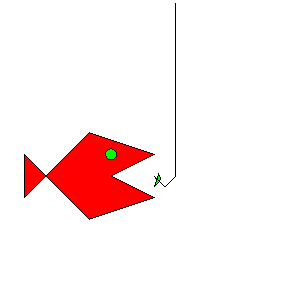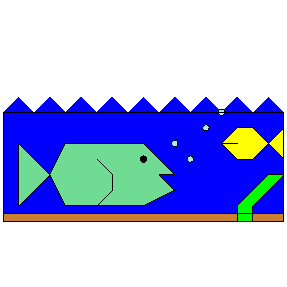

The students learn: coordinates in the plane and angular measure in radians; and use translations, rotations, polygons, circles and disks. Some students also use reflections, dilations, arcs, pie slices, ellipses. A few students have even made 3D animations using 3D translations, rotations, reflections, dilations, cubes, spheres and cylinders. In addition, some of the students learn the programming concepts of "if" statemants and "do" loops.
There are many other programs now (such as Flash® from Macromedia®) which make it easier to make animations. However, we use Maple because it forces the students to learn math. Most other programs make the pictures by drag and drop, whereas Maple forces the students to work algorithmically. For example, Maple requires all angles to be specified in radians. However, recall that at this age most of the students have not yet learned degree measure, let alone radian measure. So, we have the students stand up and do an about face and we say "That's called π." Then they do a left face which we call 1/2 π and a right face which we call -1/2 π. Then we ask "What do you think 1/4 π is?" and they do the appropriate half of a left face. After a few more turns, they have the idea. The benefit here is that the students are learning radian measure directly instead of converting from degrees. This is analogous to learning metric units directly instead of converting from conventional units.
The students begin work on the movies on the first day of camp and return to the computer lab repeatedly during the two weeks. The students can also come to the computer lab for an elective hour at the end of each day. They start by going through the two worksheets available at www.math.tamu.edu/~yasskin/animaple/makemovie/ In the first worksheet, the students make a winking happy face. In the second worksheet, they learn most of the Maple commands available for making their movies. Then they are on their own. Each lab period, we have several grad, undergrad and highschool students there to help debug their Maple code. We are always amazed at how the students go from no knowledge of Maple to some excellent animations in less than 2 weeks.
Prizes are awarded in each age group, according to esthetic quality and technical ability. To see the students' movies go to www.math.tamu.edu/outreach/SEE-Math/ click on 2002, 2004, 2005, 2006, 2007 or 2008 and then follow the links to the movies for each grade group. Click on the student's name to see the movie. Click on Maple Worksheet to see the Maple commands used to make the movie. (You will need Maple to see the worksheet.)